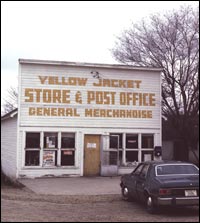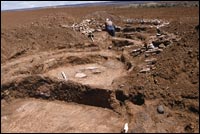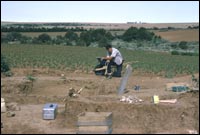Yellow Jacket History
In the fall of 1953 Hod Stevenson, a farmer from the small town of Yellow Jacket, Colorado, sent some pottery into the University of Colorado Museum along with a letter describing the site where he had encountered it. He found the pottery while plowing a new parcel of land in the summer and he had been impressed by the burned "house" and trash associated with the site. In his letter he inquired if the Museum was interested in "working" the site. Joe Ben Wheat had only recently been appointed Curator of Anthropology at the Museum, but he recognized that the pottery was early, and probably dated to Basketmaker III (AD 500-750). Wheat had just finished a masterful dissertation on Mogollon pithouse sites of the same age and he saw Stevenson's offer as an opportunity to expand his interest to the early pithouse sites of the Mesa Verde region, so he accepted the offer.
Wheat began work at Site 5MT1 (originally called the Stevenson site) in 1954, with a field crew consisting of himself, his wife Pat, and three students. The focus of their first three seasons of field work was on the area Stevenson had plowed into, a Basketmaker III hamlet just to the north of Yellow Jacket Canyon. As he excavated both the pit houses and pit rooms associated with 5MT1, Wheat documented an architectural plan of a small roomblock of pit rooms to the north and a pithouse to the south, a layout which foreshadowed the development of above-ground Pueblo architecture in the succeeding Pueblo I period. The Basketmaker III portion of the site was just to the west of a Pueblo II and III masonry structure, and Wheat expected to find a continuation of the Basketmaker architecture underlying the later site. Because of their proximity, Wheat considered the Basketmaker structures and the masonry structures to be all one site (5MT1), but he called the Pueblo II and III masonry structures Porter Pueblo (named for Charles Porter who bought the land from Stevenson and who allowed the research to continue).
In the summer of 1957, Wheat began excavation of the masonry structures in the Porter portion of 5MT1 in order to expose the Basketmaker features that he expected underneath them. As it turned out, there was no Basketmaker occupation beneath the Pueblo occupation, but a number of features of the Pueblo occupation were so unusual that they warranted a shift in the focus of the project, to explore Pueblo II and Pueblo III developments in the region as well. Among the unusual features of the site were pitrooms and post-and-adobe architecture associated with Pueblo II pottery, carved designs in kiva floors , subterranean mealing rooms associated with kivas (Mobley-Tanaka 1997bMobley-Tanaka, Jeanette L.
1997b Gender and Ritual Space during the Pithouse to Pueblo Transition: Subterranean Mealing Rooms in the North American Southwest. American Antiquity 62:437-448.), and an apparent hiatus of occupation in the Pueblo I period (Wheat 1981Wheat, Joe Ben
1981 Yellow Jacket Canyon Archaeology. In Insights into the Ancient Ones, edited by J.H. Berger and E.F. Berger, pp. 60-66. Mesa Verde Press, Cortez, Colorado.). Many of these features had never been seen before, and flew in the face of the conventional wisdom about the culture history of the Mesa Verde region in the 1950s. The research until that time primarily depended on Kidder's early synthesis of Southwestern prehistory (1924Kidder, Alfred V.
1924 An Introduction to the Study of Southwestern Archaeology, with a Preliminary Account of the Excavations at Pecos. Department of Archaeology, Phillips Academy, Andover. Yale University Press, New Haven, Connecticut.), excavation reports by Earl Morris and Paul Martin from the 1930s, and a bit of recent salvage work done on Mesa Verde (e.g., Lancaster and Pinkley 1954Lancaster, James A. and Jean M. Pinkley
1954 Excavation at Site 16 of Three Pueblo II Mesa-Top Ruins. In Archeological Excavations in Mesa Verde National Park, Colorado, 1950, by J.A. Lancaster, J.M. Pinkley, P. Van Cleave, and D. Watson, pp. 23-86. Archaeological Research Series No. 2. National Park Service, Washington, D.C.).
With interesting new features and equally interesting questions about the occupational sequence of the region now before him, Wheat turned his attention in 1961 to the excavation of another nearby site, 5MT3, which had clear Pueblo II and Pueblo III components. After working at 5MT3 for three seasons, he returned to finish his investigations in the Porter area of 5MT1 in 1965 and 1966. There was an interlude between 1967 and 1975 during which he completed and worked on a variety of other projects related to PaleoIndian archaeology as well as Southwestern textiles. With the resumption of a Yellow Jacket field school of 1975 he transferred his energies back to Site 5MT3 and continued to return to the site until 1991. Excavations at 5MT3 showed an absence of occupation during the Pueblo I and early Pueblo II periods as was the case at 5MT1, and also reconfirmed the use of post-and-adobe architecture during Pueblo II times and carved floors in later kivas. In addition, convincing evidence of group violence resulting in cannibalism and mass inhumation was also documented at both 5MT1 and 3 (Darling 1999Darling, J. Andrew
1999 Mass Inhumation and the Execution of Witches in the American Southwest. American Anthropologist 100:732-752.; Malville 1989Malville, Nancy J.
1989 Two Fragmented Human Bone Assemblages from Yellow Jacket, Southwestern Colorado. Kiva 55:3-22.; White 1992White, Timothy D.
1992 Prehistoric Cannibalism at Mancos 5MTUMR-2346. Princeton University Press, Princeton, New Jersey.).
Wheat officially retired from the CU Museum in 1983, but continued to work at Yellow Jacket after his retirement. Beginning in 1986, a new curator, Dr. Frederick Lange, took on the administration of the Yellow Jacket Field School. While Wheat continued to work at 5MT3, Lange began the excavation of another Yellow Jacket site, 5MT2, on the hilltop near 5MT1. The research design for work at 5MT2 was proposed by graduate student John Cater, who used the excavations at that site as the subject for his master's thesis (Cater 1989Cater, John D.
1989 Chronological Understanding of Site 5MT2, Yellow Jacket, Colorado, and a Study of Abandonment Modes. Unpublished MA thesis, Department of Anthropology, University of Colorado, Boulder.). Excavations at 5MT2 revealed a less stratigraphically complex site than either 5MT1 or 5MT3, with spatially separate early and late Pueblo III components. Yet, it also showed that the later Pueblo occupations at 5MT1 and 2, overlapped at several points in time. Given the potential contemporaneity and proximity of the roomblocks at 5MT1 and 2 and an unexcavated Pueblo II-III site just to the east of 5MT2, it appears that this small cluster of roomblocks may have functioned as a unitary group in late Pueblo times. As was the case with Wheat's original excavations in the 1950s, nothing—not even the archaeology at 5MT2—proved simple at Yellow Jacket.



